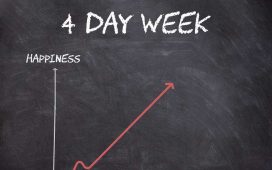Mike Hopkins, the senior vice president of Prime Video and Amazon Studios, said at an internal meeting recently about Amazon’s mandate forcing employees to work in the office rather than from home: “It’s working…. I don’t have data to back it up, but I know it’s better.”
He added that it’s the “personal belief” of Amazon CEO Andy Jassy that in the office is where employees do their best work.
Jassy shares that belief with other tech CEOs, including Tesla and SpaceX CEO Elon Musk and Google and Alphabet CEO Sundar Pichai, as well as business leaders across the spectrum of industries.
Hopkins’ claim reveals what’s really behind back-to-office mandates: irrationality — specifically, favoring “belief” over data.
Hopkins says he doesn’t have data, but he does. Unfortunately for him, the data doesn’t agree with his “belief.”
We live in an age in which people flaunt data when it agrees with their view point, but do something else when the data disagrees. (And this is as true in business as it is in politics.) Here’s what people do when facts contradict what they want to belief:
- They say “it’s complicated.” (When data agrees, it’s simple. When data disagrees, it’s complicated.)
- They make up “alternative facts” that support their position. (We see this every day in all kinds of public discourse.)
- Or, as Hopkins does, they deny the opposing facts exist. (Only the facts that support my beliefs exist.)
Hopkins’ cop-out is especially disappointing because Amazon is a famously data-centric, data-driven company.
Let’s look at the data
A tech.co survey found that slightly less than half (47%) of companies experienced higher productivity by remote employees.
One-third (32%) of hiring managers say productivity has increased since remote work policies were implemented and 22.5% found that it decreased, according to an Upwork survey.
Prodoscore data says that productivity depends on the employee and how they’re managed, not whether they’re working from home or in an office. If they’re productive in the office, they’ll be productive working from home, according to the firm’s evaluation of 105 million data points.
More importantly, remote and hybrid work improved factors beyond productivity. Two studies by Owl Labs found that remote and hybrid employees were 22% happier than workers in an onsite office environment — and stayed in their jobs longer.
Other research, including from Ergotron, found that remote work improved employees’ physical and mental health and bolstered their job satisfaction.
Early in the pandemic, data emerged showing decreases in productivity for WFH employees. More recently, the reason for that became clear.
Stanford Economics Professor Nick Bloom aggregates mountains of data on remote and hybrid work, as well as return-to-office mandates; he concludes that hybrid work provides small improvements in productivity, whereas full-remote work is negative when badly managed and positive when well managed. In other words: “Hybrid and even fully remote teams can gain a substantial productivity advantage if their leaders stop relying on traditional office-based culture and methods of collaboration.”
Bloom said: “It is frustrating hearing anecdotes from a few high-profile CEOs and politicians about the end of WFH. If we look at the data instead, we see it is the Return to Office [that] died in early 2023. Since then, office occupancy and WFH have been flat across the US,” which he illustrated by posting two trend charts on X (formerly Twitter) showing the flattening of people working from home and also office occupancy.
We have reached a new normal, where neither working from home nor returning to the office is rising or falling.
What will continue to change is that when people who want to work from home look for jobs, they’ll look for WFH jobs, causing a subtle talent transfer away from office-mandate companies. The process of quality employees migrating toward WFH jobs will continue, even as the percentage of WFH jobs remains constant.
Which brings us to the real problem
Today’s leaders rose up the ranks through their success in the pre-WFH era. They mastered the art of managing staffers in person, for the most part, and that’s why they’re leaders today.
Tomorrow’s leaders will have to be adept at managing remote staff.
The transition from all in-office to hybrid and remote work is akin to the introduction of sound to motion pictures in the 1920s and 1930s.
When “The Jazz Singer” debuted in 1927, the studio couldn’t imagine a fully talking picture. So the movie is a hybrid between a silent movie and a “talkie,” as were all the early movies with sound. The industry went hybrid, too, with some films silent and others with sound. It was the hardship of the Great Depression that forced studios to pick one, and they picked sound.
Over the years, Hollywood studios ended up embracing movies with soundtracks, and entire industries emerged to support the technology and profession of making multimedia films.
Many stars and leaders of the silent era adapted to become successful in the new era. Those who couldn’t adapt fell by the wayside. The most successful actors of the silent era, including Gloria Swanson, Douglas Fairbanks and Mary Pickford, couldn’t succeed in talkies. Big-name directors were replaced by theater directors, who had experience with dialog and audio matters.
Some of today’s business leaders seem to have no clue that we’ve entered a new era with a new set of criteria for success in leadership. Instead, they want to use their authority to force companies to live in the past.
There is a long list of soft skills, and nuanced practices that lead to success when leading remote and hybrid teams. But the first step is to change “personal beliefs” unsupported by data.
Here are the new leadership beliefs that are, in fact, supported by data:
- Effective leadership is usually not about control or micromanagement.
- You can’t actually tell whether someone is productive by looking at them. It’s a delusion.
- Collaboration is nice (and is, in fact, enhanced by proximity), but focused, uninterrupted deep work is nicer. In general, collaboration is best for ideation, but uninterrupted deep work is best for execution. The vast majority of time is spent on the latter. People do their best work not when they’re physically in an office, but when they have the flexibility to work when and where they choose. Check your collaboration bias.
My advice to business leaders is this: If your “personal belief” tells you that in-office work is better, approach the question analytically. What actual, measurable problems related to your business objectives will be solved by a return to the office?
Look to the data. And if you find that the facts disagree with your beliefs, change your beliefs. Don’t pretend the data doesn’t exist.
Copyright © 2024 IDG Communications, Inc.












